Fuels
Fuel additive sea trials
08 July 2025
07 December 2020
Refiners look to additive response models to help optimise fuel production

Economic uncertainty combined with changes in supply and demand, increasing refinery complexity, and a volatile product mix are all putting pressure on refiners to improve efficiency and maximise returns. Dhanesh Goberdhan, Infineum Research Scientist, explains how advanced modelling tools are helping to not only solve routine operational issues at the refinery but also to develop future pathways to improved profitability.
Even prior to the COVID-19 crisis, many refineries were under pressure and operating in an increasingly dynamic environment. But, this situation has now been further compounded by the pandemic and the resulting impact on economic activity. In these uncertain times, the use of enhanced modelling tools is even more important as refiners strive to operate more efficiently by quickly solving day-to-day operational issues and looking out to the future to find opportunities to increase value.
A number of factors are making the environment in which refineries operate increasingly complex. Firstly, we have seen a very dynamic supply and demand picture, influenced for example by:
In addition, the trend to larger, more complex refineries means different component blend streams have become available, which increases the range of options for final product blending. This complexity is further compounded by the availability of blend components that are non-fossil fuel, such as hydrogenated vegetable oil (HVO).
Refineries need to gain a good knowledge and understanding of their flexibility in order to be able to optimise the product mix and maximise value.
Last, but not least, the fuel product mix is also markedly volatile and refiners are looking for the answers to a number of important questions. Will the market continue to be dominated by variations in diesel and gasoline? And, if it is, for how long will that go into the future? How might diesel and gasoline need to evolve to meet the shifting climate change requirements? To what extent will refinery production be further affected by the increase in low sulphur marine diesel demand due to IMO 2020 sulphur specification? Which specifications of diesel, fuel oil, heating oil and marine gas oil grades will be the best value to produce? What is the best available crude source to meet requirements?
With so many uncertainties, refineries need to have the flexibility to manage the proportion and types of middle distillate fuels they produce.
Refineries use mathematical models to optimise their production to meet their needs. However, according to a famous quote, often attributed to the British statistician George E. P. Box, “All models are wrong, but some are useful”. The idea behind this statement is that although a model will never represent the exact reality of a situation, it can still be very helpful in better understanding certain aspects.
By understanding the limitations of a model it may be possible to answer appropriate questions.
The modelling tools that refiners use are generally referred to as linear programming (LP) and tend to be proprietary in nature. However, modern versions are non-linear and of great complexity, being designed to aid planners and schedulers in operating the refinery while also maximising refinery economics. These models are based on one or more input streams into the processing units and one or more output streams. The starting point for the process is the crude distillation unit (CDU) where different fractions are cut according to their boiling point and the temperatures where those cuts are made are chosen so as to be the most efficient for the crude being processed.
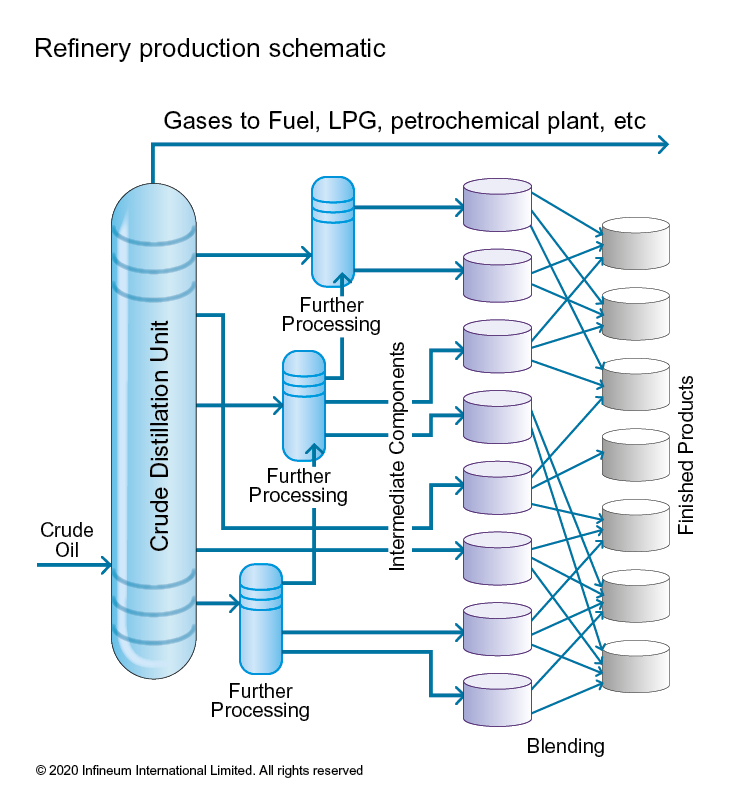
Models use one or more of the refinery processing unit input and output streams
From a modelling perspective, refineries consist of process units, materials to transform and blend together and finished products, which have specifications. The mathematical models used by refineries can have different objectives. At one extreme, models are used to help in long term strategic planning, for example in selecting the crude diet for future planning cycles. At the other extreme, models are used to help short term optimisation of refinery processes.
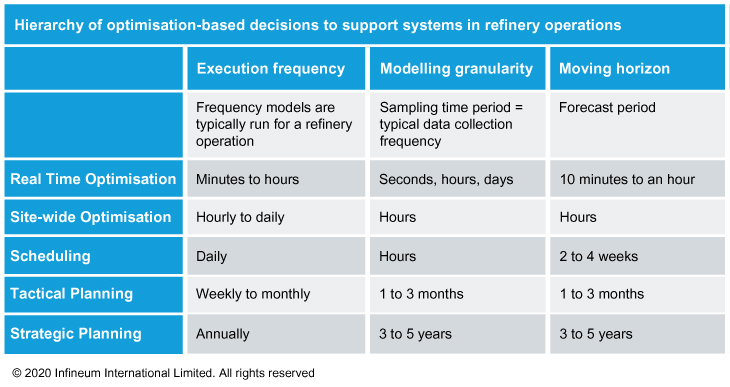
Examples of the applications of operational optimisation encompassing extremes in time scale
To maximise profitability in the dynamic environment in which they operate, and to be able to produce the optimum fuel mix, refineries need to be very flexible. Models are important tools to help refiners define the boundaries for refinery operations and to understand what might be feasible.
Refiners are looking for the maximum flexibility in blending fuel components to allow them to take advantage of the dynamic environment in which they operate. Additives are key enablers that help to increase flexibility for the refiner in producing fit for purpose fuels, by expanding the boundaries that would restrict production.
An example of one key strategy to increase the overall value of the product mix that refiners can obtain from a barrel of oil is to produce a greater proportion of ‘lighter’ products such as jet fuel, which are generally more valuable than heavier products.
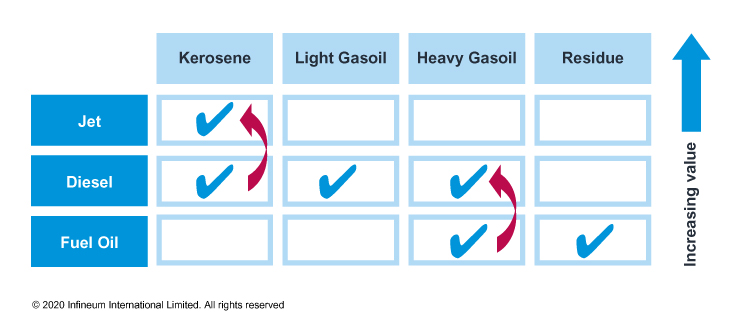 Strategy to increase the overall value of the product mix
Strategy to increase the overall value of the product mix
However, removing kerosene from diesel and/or adding fuel oil into diesel changes the properties of the diesel. Reduction in kerosene content to increase jet production, or increasing heavier components in diesel worsens the cold flow properties and limits how much 'upgrading' is possible. Cold flow additives can increase a refiner’s capability to overcome this constraint, thus increasing flexibility.
Cold flow additives enable refiners to upgrade lower value blend streams to produce higher value products.
A typical example is blending middle distillate fuels to higher cloud point (CP) and using cold flow additives to compensate for the worsening properties. However, current refinery LP models do not take into account the opportunities that are offered by additive technology.
Cold flow additive response is sensitive to the molecular composition of middle distillate fuels, and this is highly dependent on the crude source. However, these middle distillates, such as diesel fuels, are often the result of blends of different refinery streams, which may be from straight run distillation columns or additional processing units in the refinery such as the fluid catalytic cracker (FCC), coker, visbreaker, hydrocracker and/or thermal cracker. This results in diesel and other middle distillate products, containing an increasingly more varied series of molecules in variable proportions. Different blend streams can contain different levels of n-alkanes, iso-alkanes, olefins, naphthenic and aromatic compounds.
The final middle distillate blend may not only contain a variety of hydrocarbon molecules but also increasingly could have additional molecules from biofuel sources. The change and variation in the molecular composition of the middle distillate fuel will impact its properties, including those related to cold flow. The molecular composition impacts the crystallisation of the n-alkanes, which is also influenced by the properties of the solvent from which they precipitate.
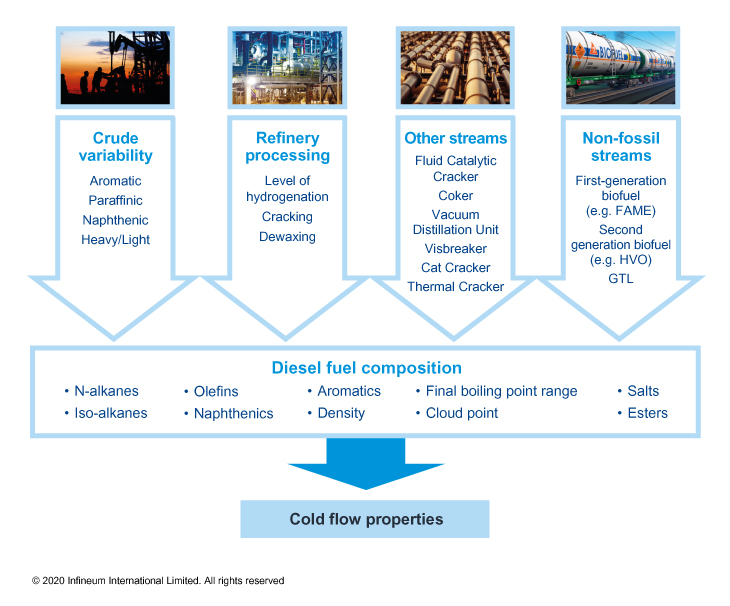 Factors contributing to the increased complexity of diesel fuels
Factors contributing to the increased complexity of diesel fuels
The effectiveness of cold flow additives is highly dependent on fuel composition, which is becoming progressively more complex and variable. This means modelling the ways cold flow additives respond in a given fuel is increasingly important and powerful.
Infineum has been building expertise in understanding the cold flow properties of middle distillates and other fuel types and their response to cold flow additives. This has employed large databases of fuel characteristics and data on cold flow additives response in different fuels that has been developed over decades of research. Infineum’s advanced formulation approach methodology and experience of developing cold flow models is described in two recent conference papers1.
These models overcome the complexity of cold flow additive responsiveness and have led to the development of improved modelling tools to aid customers in their day-to-day operations and longer term scenario planning. This enables refiners to better understand the impact of changes required to deliver fuels meeting their final customer requirements. The value of using fuel characteristics to predict and model the responsiveness of additives enables the development of tools to test the boundaries resulting from blend component and thus can be used to optimise refinery performance.
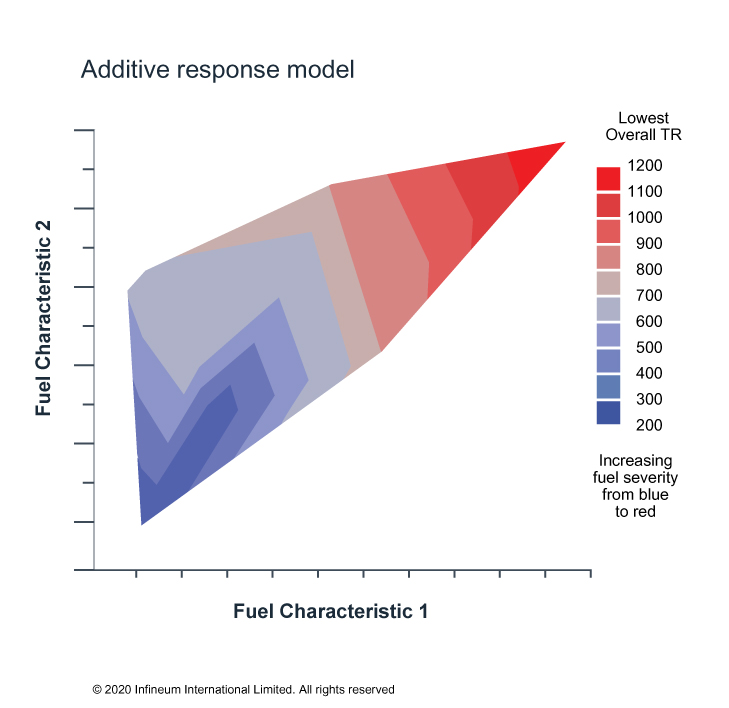 Based on fuel characteristics, additive response models can be developed that indicate the responsiveness of fuels to an additive technology
Based on fuel characteristics, additive response models can be developed that indicate the responsiveness of fuels to an additive technology
These fuel additive response severity models can be used to assist decision making in a number of ways. On a day-to-day basis, refiners can more accurately predict the responsiveness of an additive for blended finished fuels and optimise the use of additives. Additive companies can use the models to respond more rapidly to refiners concerns about additive responsiveness. These models can be used to understand whether fuel blends are optimally treated by an additive technology, whether an alternative additive technology is required or if a different fuel blend recipe altogether is required. Finally, this type of tool can enable refineries to test different scenarios in order to establish what and how fuels can be blended while still ensuring the resulting products are fit for purpose.
In our view, advanced modelling has the potential to deliver even more value to the refiner. With the appropriate data, it is possible to extend the models from looking at the ways diesel fuel properties impact cold flow additive response to further back in the refinery process. Namely to the impact of the variation in fuel streams that produce the diesel and ultimately to the variation in crude sources that produce the fuel stream.
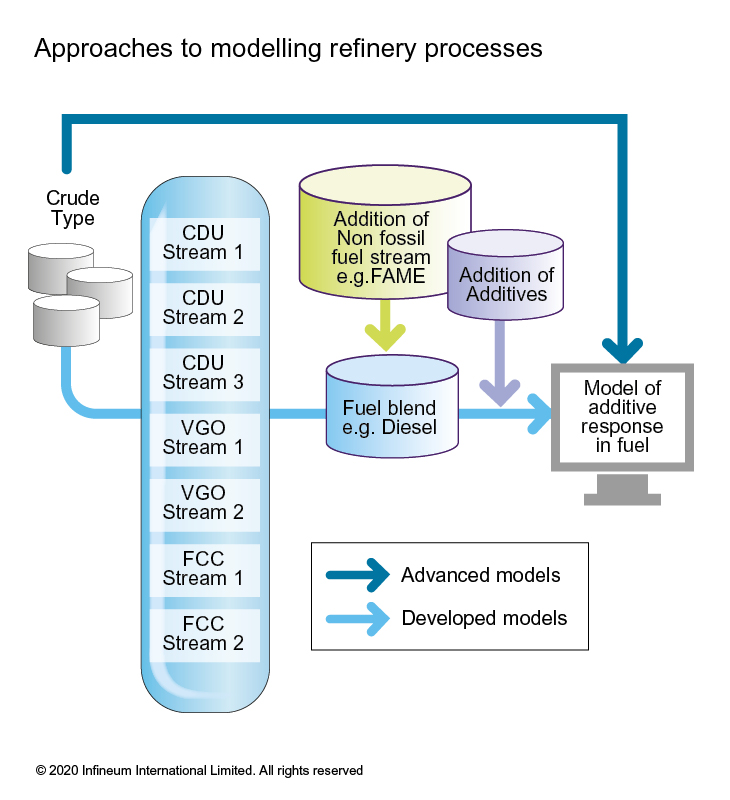 Advanced modelling has the potential to deliver even more value to the refiner
Advanced modelling has the potential to deliver even more value to the refiner
Infineum has been working to develop advanced models that are capable of linking the properties of crude oil to additive response. The value of linking LP models to additive response provides refineries with powerful tools that can help to:
Reduce refinery costs
Maximise production value
Improve refinery efficiency
Models and modelling tools can be developed and provided to customers for incorporation into their systems. Alternatively a more collaborative approach can be taken, where data is continuously shared between the refiner and fuels experts at Infineum. The latter approach has the benefit of developing faster service response times, helping to avoid the issues around updating the tool and allowing continuous improvement of the tool.
By timely monitoring of data, more rapid interventions are possible, which can capture value or tackle issues. The regular automatic data exchange approach offers savings and improved profitability by increasing the responsiveness of technical service advice, which can create more value and profitability for the refiner.
1: Recent papers: SAE 2019-01-1921. and Goberdhan, D. “Modelling of optimal use of additives for refinery production”, 12th TAE international Colloquium Fuels, Esslingen 2019.
Sign up to receive monthly updates via email